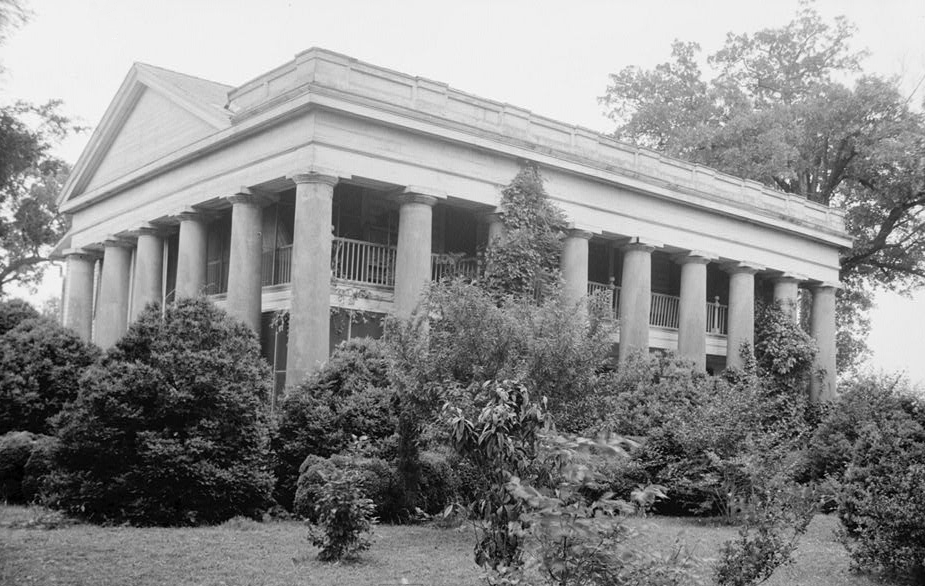- Pitts' Folly
Infobox_nrhp
name =Pitts' Folly
nrhp_type =

caption = The front elevation of Pitts' Folly in 1935.
lat_degrees = 32
lat_minutes = 26
lat_seconds = 42.22
lat_direction = N
long_degrees = 87
long_minutes = 30
long_seconds = 29.88
long_direction = W
location =Uniontown,Alabama ,United States
area =
built =1852-53
architect=B. F. Parsonscite web|title="Alabama: Perry County "|work="National Register of Historic Places"|url=http://www.nationalregisterofhistoricplaces.com/AL/Perry/state.html|accessdate=2008-02-15]
architecture= Greek Revival
designated=
added =August 9 ,1984 cite web|url=http://www.nr.nps.gov/|title=National Register Information System|date=2008-02-15|work=National Register of Historic Places|publisher=National Park Service]
governing_body = Private
refnum=84000717Pitts' Folly is a historic
antebellum Greek Revival residence located in Uniontown,Alabama . The house was built by Phillip Henry Pitts as his main home. It was designed by architect B. F. Parsons, who also designed the nearby Perry County Courthouse in Marion. Many local legends detail how the house gained its name, but they all center around the fact that the people of Uniontown believed it to be folly, or foolishness, that Pitts was building such a large house.Hammond, Ralph "Ante-bellum Mansions of Alabama", page 138. New York: Architecural Book Publishers, 1951. ISBN 0517020750]History
Phillip Henry Pitts was born 3 June 1814 in
Essex County, Virginia . He was the son of Thomas Daniel Pitts, a veteran of theWar of 1812 who moved his family to Uniontown in 1833. Pitts married in 1841 to Margaret Davidson, the sister ofAlexander C. Davidson .cite web|title="Philip Henry Pitts Papers, 1814–1889"|work="Records of Ante-Bellum Southern Plantations From The Revolution Through The Civil War"|url=http://www.lexisnexis.com/documents/academic/upa_cis/2444_AnteBellSouthPlanSerJPt7.pdf|accessdate=2008-02-15] The Davidsons were descendants ofWilliam Lee Davidson , a general during theAmerican Revolutionary War and founder ofDavidson College inNorth Carolina . Pitts himself was a large contributor to the college within his lifetime and his plantation diaries were later donated to it for preservation. Phillip Pitts recorded in his diary that construction of the house began on 27 February 1852. He also recorded the house being completed in April 1853. His assets by 1860 were valued at $175,300. At this time he owned two additional plantations, "Rurill Hill" and "Kings" for a total of convert|2200|acre|ha. He also owned stock in the Alabama-Mississippi Railroad and held at least 89 slaves. The Pitts' had ten children, most of whom were raised in the house, with two dying in theAmerican Civil War .cite web|title="Pitts' Folly (Data pages)"|work="Historic American Buildings Survey"|url=http://hdl.loc.gov/loc.pnp/hhh.al0685|accessdate=2008-02-15] Phillip Pitts remained a cottonplanter until his death on 22 April 1884. The house continues to be occupied by the descendants of Phillip Pitts to the present day.Description
Pitts' Folly is a two-story wood frame structure with wooden clapboarding. The roof is gabled on the east and west sides, with a flat roof over the portico. The front and eastern elevations feature a two-story
portico with fourteen masonry Doric columns, nine across the front and five on the east side. A self-supporting second floor balcony wraps both sides of the house under the portico. The interior is divided on both floors by a central hallway. Several rooms feature decorativeplasterwork . The house and grounds were surveyed in 1935 and 1936 by theHistoric American Buildings Survey . It was added to theNational Register of Historic Places in 1984.Gallery

ee also
*
National Register of Historic Places listings in Perry County, Alabama References
Wikimedia Foundation. 2010.
